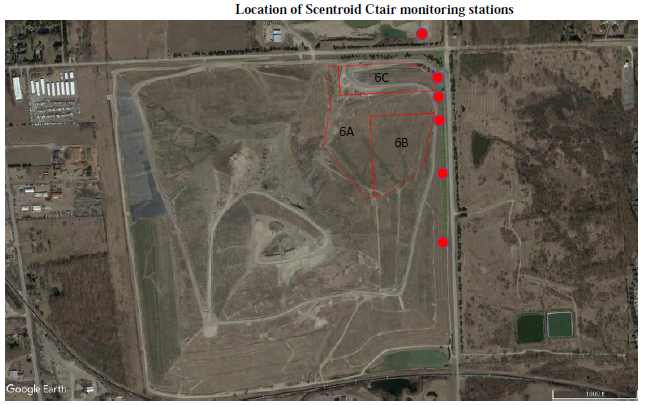One of the most significant pieces of the Arbor Hills Consent Judgement is a requirement for Arbor Hills to install and maintain a network of air monitoring stations on the perimeter of the landfill. Appendix G of the Consent Judgement contains the details for the perimeter monitoring system. Methane (CH4) and Hydrogen Sulfide (H2S) concentrations must be continuously monitored for the next 10 years. A weather station mounted on a 10-meter-high tower will monitor local weather conditions and sophisticated software will be used to gather and analyze the data.
Portions of the perimeter monitoring system are in place today. By mid-April, The Consent Judgement requires six monitoring stations to be installed in the locations shown in Figure 1. By early May a website to allow the public to access data from the perimeter monitoring stations in near real-time is required. [Near real-time is not defined in the Consent Judgement. We have asked EGLE for their expectations.]
It has long been our belief that wind speed and direction, coupled with odor measurements should allow the landfill or EGLE to quickly pinpoint the source of the odors.
Figure 1 - Landfill Perimeter Monitoring Locations
Monitoring for emissions from landfills can be tricky as there are hundreds of potential compounds which may be emitted. EGLE worked hard to determine what compounds could be reliably monitored to provide useful information to the community.
Hydrogen sulfide (H2S) is toxic, very odorous, and is believed to be responsible for many of the landfill odors. H2S has the smell of rotten eggs. Methane is the main component of natural gas (>85%) and landfill gas (40 – 50%). Methane does not have an odor and is not believed to be toxic but is easily measured and serves as an indicator for releases of landfill gas.
Figure 2 - Picture of monitoring station located on Napier Road on the perimeter fenceline
On Sunday, March 21st something happened at the Arbor Hills Landfill which resulted in excess emission and noxious odors in the Northville Township Neighborhoods. Over 50 odor complaints were submitted by the community that evening beginning at about 8:00 PM. As typical, we did not hear a response from Arbor Hills even after reaching out to them.
EGLE responded to the site at approximately 2:30 AM and used their portable H2S and Methane meters to perform a quick perimeter survey in the areas where odors were detected. Methane was detected along Napier Road between Five Mile and Six Mile Roads. A narrow area along Napier Road had much higher concentrations indicating a point source was responsible upwind. EGLE easily found methane emissions further downwind in the Northville Ridge neighborhood and used the wind direction to determine the likely source of the emissions was one of the landfill’s flares. Further investigation determined the flare had malfunctioned (un-combusted landfill gasses were being emitted). Although the perimeter monitoring system is not yet fully operational, EGLE verified the excess Methane emissions were detected by perimeter monitors and exceeded the “action levels” prescribed in the Consent Judgement.
… if any of the monitoring stations detect H2S or methane above the respective action level, then AHL shall conduct a root cause analysis of the exceedance(s) and implement corrective actions, as necessary, to correct the exceedance(s) and prevent the exceedance(s) from recurring…
Although the details from March 21st odor incident are not yet available, the flares at Arbor Hills have been a systemic problem for a long time. We expect Arbor Hills will be presenting their root cause analysis and proposed corrective actions to EGLE this week. EGLE can issue a violation for the flare malfunction and may have the ability to demand stipulated penalties if any of the provisions of the Consent Judgement were not followed.
The Conservancy Initiative believes the perimeter monitoring station is another tool, which generates data, that can be used to document the landfill’s performance. We are encouraged the perimeter monitoring system was able to detect the recent odor incident and would like to see how the software used the weather information in conjunction with the emission data to locate the source of the excess emissions.
Finally, EGLE is planning a virtual town hall to explain the Consent Judgement and answer any questions the community may have. The Conservancy Initiative is working with community leaders to review the Consent Judgement and submit our questions to EGLE. The date and time for the town hall are expected to be announced within the week.



